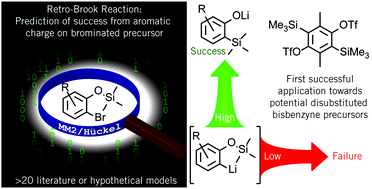A simple Hückel model-driven strategy to overcome electronic barriers to retro-Brook silylation relevant to aryne and bisaryne precursor synthesis†
Abstract
ortho-Silylaryl triflate precursors (oSATs) have been responsible for many recent advances in aryne chemistry and are most commonly accessed from the corresponding 2-bromophenol. A retro-Brook O- to C-silyl transfer is a key step in this synthesis but not all aromatic species are amenable to the transformation, with no functionalized bisbenzyne oSATs reported. Simple Hückel models are presented which show that the calculated aromaticity at the brominated position is an accurate predictor of successful retro-Brook reaction, validated synthetically by a new success and a predicted failure. From this, the synthesis of a novel difunctionalized bisaryne precursor has been tested, requiring different approaches to install the two C-silyl groups. The first successful use of a disubstituted o-silylaryl sulfonate bisbenzyne precursor in Diels–Alder reactions is then shown.



 Please wait while we load your content...
Please wait while we load your content...